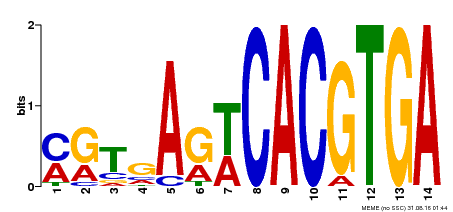 |
PlantRegMap/PlantTFDB v5.0
Plant Transcription
Factor Database
|
| Home TFext BLAST Prediction Download Help About Links PlantRegMap |
Transcription Factor Information
| Basic Information? help Back to Top | |||||||||
|---|---|---|---|---|---|---|---|---|---|
| TF ID | Thhalv10027186m | ||||||||
| Common Name | EUTSA_v10027186mg | ||||||||
| Organism | |||||||||
| Taxonomic ID | |||||||||
| Taxonomic Lineage |
cellular organisms; Eukaryota; Viridiplantae; Streptophyta; Streptophytina; Embryophyta; Tracheophyta; Euphyllophyta; Spermatophyta; Magnoliophyta; Mesangiospermae; eudicotyledons; Gunneridae; Pentapetalae; rosids; malvids; Brassicales; Brassicaceae; Eutremeae; Eutrema
|
||||||||
| Family | bHLH | ||||||||
| Protein Properties | Length: 214aa MW: 24679.6 Da PI: 5.7973 | ||||||||
| Description | bHLH family protein | ||||||||
| Gene Model |
|
||||||||
| Signature Domain? help Back to Top | |||||||
|---|---|---|---|---|---|---|---|
| No. | Domain | Score | E-value | Start | End | HMM Start | HMM End |
| 1 | HLH | 31.3 | 3.7e-10 | 35 | 78 | 7 | 55 |
HHHHHHHHHHHHHHHHHHCTSCCC...TTS-STCHHHHHHHHHHHHHHH CS
HLH 7 erErrRRdriNsafeeLrellPkaskapskKlsKaeiLekAveYIksLq 55
e+ErrRR+++ ++ Lr+++P + ++Ka+i+e A+ YI +Lq
Thhalv10027186m 35 EAERRRREKLHCRLMALRSHVPIV-----TNMTKASIVEDAITYIGKLQ 78
79*********************8.....69***************998 PP
| |||||||
| Protein Features ? help Back to Top | ||||||
|---|---|---|---|---|---|---|
| Database | Entry ID | E-value | Start | End | InterPro ID | Description |
| SuperFamily | SSF47459 | 2.22E-14 | 25 | 93 | IPR011598 | Myc-type, basic helix-loop-helix (bHLH) domain |
| CDD | cd00083 | 1.46E-10 | 26 | 82 | No hit | No description |
| PROSITE profile | PS50888 | 13.96 | 28 | 77 | IPR011598 | Myc-type, basic helix-loop-helix (bHLH) domain |
| SMART | SM00353 | 8.8E-11 | 34 | 83 | IPR011598 | Myc-type, basic helix-loop-helix (bHLH) domain |
| Gene3D | G3DSA:4.10.280.10 | 8.4E-13 | 35 | 93 | IPR011598 | Myc-type, basic helix-loop-helix (bHLH) domain |
| Pfam | PF00010 | 8.9E-8 | 35 | 78 | IPR011598 | Myc-type, basic helix-loop-helix (bHLH) domain |
| Gene Ontology ? help Back to Top | ||||||
|---|---|---|---|---|---|---|
| GO Term | GO Category | GO Description | ||||
| GO:0006355 | Biological Process | regulation of transcription, DNA-templated | ||||
| GO:0048658 | Biological Process | anther wall tapetum development | ||||
| GO:0005634 | Cellular Component | nucleus | ||||
| GO:0003700 | Molecular Function | transcription factor activity, sequence-specific DNA binding | ||||
| GO:0043565 | Molecular Function | sequence-specific DNA binding | ||||
| GO:0046983 | Molecular Function | protein dimerization activity | ||||
| Sequence ? help Back to Top |
|---|
| Protein Sequence Length: 214 aa Download sequence Send to blast |
MGGGSRYQEP VRMSRRRQVR KEKQEDESFK SPNLEAERRR REKLHCRLMA LRSHVPIVTN 60 MTKASIVEDA ITYIGKLQME VENLTEKLHE IEEAPPEMDE QRTNLIIKPE HETIDLIEEI 120 KKLGIEENVQ LFKIGDRKFW LKITTEKKPG IFTKLMEVMR FIGFEIIDVS LTTSSGAILI 180 CSSVQILQGL CDGDSVDLEQ TKEFLLEVMK SYP* |
| Nucleic Localization Signal ? help Back to Top | |||
|---|---|---|---|
| No. | Start | End | Sequence |
| 1 | 36 | 41 | ERRRRE |
| 2 | 37 | 42 | RRRREK |
| Functional Description ? help Back to Top | ||||||
|---|---|---|---|---|---|---|
| Source | Description | |||||
| UniProt | Transcription factor. Involved in the control of tapetum development. Required for male fertility and pollen differentiation, especially during callose deposition. {ECO:0000269|PubMed:16831835}. | |||||
| Binding Motif ? help Back to Top | |||
|---|---|---|---|
| Motif ID | Method | Source | Motif file |
| MP00091 | SELEX | Transfer from AT4G21330 | Download |

| |||
| Cis-element ? help Back to Top | |
|---|---|
| Source | Link |
| PlantRegMap | Thhalv10027186m |
| Regulation -- PlantRegMap ? help Back to Top | ||||||
|---|---|---|---|---|---|---|
| Source | Upstream Regulator | Target Gene | ||||
| PlantRegMap | Retrieve | Retrieve | ||||
| Annotation -- Nucleotide ? help Back to Top | ||||||
|---|---|---|---|---|---|---|
| Source | Hit ID | E-value | Description | |||
| GenBank | HQ379629 | 2e-71 | HQ379629.1 Arabidopsis lyrata haplotype Aly-S16 S-locus region genomic sequence. | |||
| Annotation -- Protein ? help Back to Top | |||||||
|---|---|---|---|---|---|---|---|
| Source | Hit ID | E-value | Description | ||||
| Refseq | XP_006413791.1 | 1e-155 | transcription factor DYT1 | ||||
| Swissprot | O81900 | 1e-116 | DYT1_ARATH; Transcription factor DYT1 | ||||
| TrEMBL | V4MFH3 | 1e-153 | V4MFH3_EUTSA; Uncharacterized protein | ||||
| STRING | XP_006413791.1 | 1e-154 | (Eutrema salsugineum) | ||||
| Orthologous Group ? help Back to Top | |||
|---|---|---|---|
| Lineage | Orthologous Group ID | Taxa Number | Gene Number |
| Malvids | OGEM8358 | 25 | 38 |
| Best hit in Arabidopsis thaliana ? help Back to Top | ||||||
|---|---|---|---|---|---|---|
| Hit ID | E-value | Description | ||||
| AT4G21330.1 | 1e-109 | bHLH family protein | ||||
| Link Out ? help Back to Top | |
|---|---|
| Phytozome | Thhalv10027186m |
| Entrez Gene | 18029590 |



